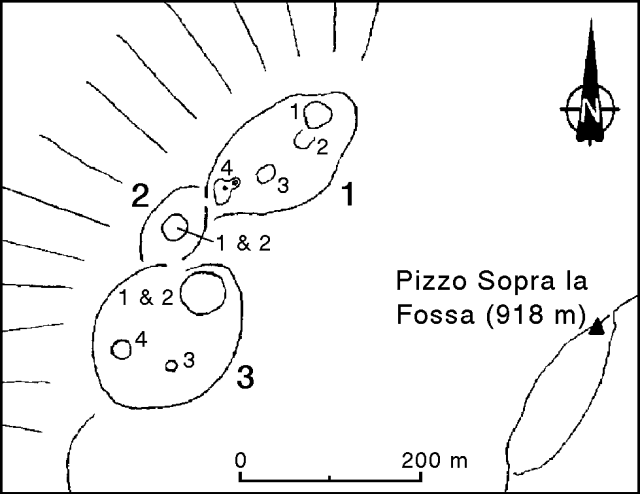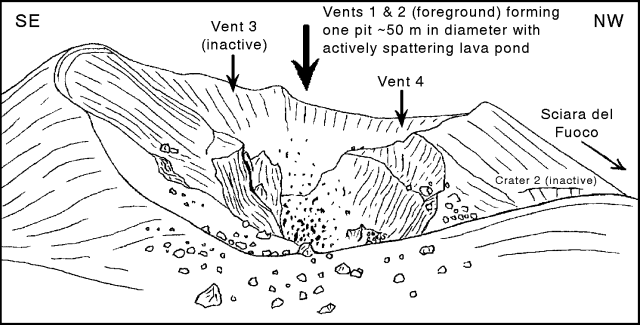Report on Stromboli (Italy) — March 1994
Bulletin of the Global Volcanism Network, vol. 19, no. 3 (March 1994)
Managing Editor: Richard Wunderman.
Stromboli (Italy) Normal Strombolian activity; crater descriptions
Please cite this report as:
Global Volcanism Program, 1994. Report on Stromboli (Italy) (Wunderman, R., ed.). Bulletin of the Global Volcanism Network, 19:3. Smithsonian Institution. https://doi.org/10.5479/si.GVP.BGVN199403-211040
Stromboli
Italy
38.789°N, 15.213°E; summit elev. 924 m
All times are local (unless otherwise noted)
"On two of three visits during 9-12 March, very detailed observations of crater morphology and eruptive activity were made. The volcano continues its millennia-long eruption; the intensity of the current activity is considered normal and characteristic of Stromboli's persistent activity. A brief visit to the Pizzo Sopra la Fossa (figure 33) was carried out on the afternoon of 9 March, but due to dense weather clouds few visual observations were possible. The noise of explosions was audible every 10-15 minutes, and continuous lava splashing could be heard. Breaks in the cloud cover revealed vigorous degassing in the entire crater area.
 |
Figure 33. Sketch map of the crater area at Stromboli. Bold numbers indicate craters, smaller numbers are vents. Courtesy of B. Behncke. |
"The second summit climb and overnight stay was undertaken during much improved weather conditions, from about 1700 on 10 March until 0700 the next morning. The active craters were observed from the beginning of the visit until 0200 on 11 March. Observations were made at close range from the rim of crater 3 (the SW-most active crater) from 2130 until 2300. Eruptions from at least 3 vents all produced largely ash-free lava fountains that rose <=150 m. Vent 4 in Crater 3 (figure 34) ejected low lava fountains about every 10 minutes between 1700 and 2000, but then remained inactive for several hours. The eruptions made little noise, similar to eruptions from the same vent during visits in September 1989, March and November 1990, and August 1991. Another vent (1 & 2) was present in the NE part of Crater 3, at the location where several small incandescent pits and conelets existed in 1990-91. However, there is now a larger and deeper pit with much more vigorous activity. The pit is roughly circular and has a diameter of about 30-50 m; its bottom (and active bocca) is not visible from any accessible place on the crater rim. Nonetheless, it appears probable that there is an active, vigorously spattering lava pond in the pit.
 |
Figure 34. Sketch of Stromboli's crater 3 seen from the SE rim of crater 1, 12 March 1994. Made from a composite photograph. View is to the SW. Courtesy of B. Behncke. |
"During the 90-minute observation from the crater rim, remarkable fluctuations in pit activity were seen. There would be a period of very low-level activity (up to 5 minutes long) when little or no spatter was thrown above the pit lip. Then bombs and spatter would be obliquely projected against the S wall of the pit for several minutes. This was followed by more vigorous vertical fountains of gradually increasing height. For ~ 10-20 minutes there would be a stupendous display of such fountains until a sequence of very large fountains (up to 100 m high) marked the end of increased activity. The heat of the large fountains could be felt on the crater rim; fortunately, no bombs fell closer than 25 m to the vantage point. Three such large fountains, or fountaining sequences, were observed during the stay on the crater rim.
"Crater 2 was inactive and not visible, but vent 4 at the SW end of Crater 1 had very violent and loud eruptions every 20-30 minutes, sometimes at shorter intervals. These eruptions began instantaneously with crashing sounds and ejection of a very thin, tall, vertical incandescent column. Within ~1 second, another fountain would shoot obliquely from a second vent a few meters away and jet right through the first column; these eruptions lasted <5 seconds. Several of them were followed within the next few minutes by a series of up to four more eruptions of gradually decreasing intensity. Many bombs from the oblique fountains fell into the adjacent pit with continuous spattering. Similar activity continued after our departure to make observations from Pizzo Sopra la Fossa. Loud crashing noises from vent 4 of Crater 1 were frequently heard during attempts to sleep below the observation platform and the next morning when descending towards the village of Stromboli.
"The summit was climbed a third time during daylight on 12 March, and a visit was made to the craters from 0900 until 1100. All of the craters are significantly deeper than during visits in March 1990 and August 1991. The pit (vent 1 & 2) in Crater 3 (figure 34) was still continuously spattering and ejecting small lava fountains, but there were fewer large fountains. Vent 4 in Crater 3 ejected low lava fountains ~ 3 times, but was hidden by dense gas-and-steam clouds most of the time. Striking changes have occurred in Crater 1, probably during the violent explosions of October 1993. All cinder cones observed within this crater in 1990-91 have vanished; now there is an elongate chasm up to 60 m deep that appears to have a large but inactive fissure on its floor. An irregularly shaped vent in the NE portion of the crater, not active 10-11 March, erupted several times. These eruptions had durations of up to 30 seconds and produced low (~50 m) fountains mixed with very dense steam-and-gas plumes and accompanied by relatively loud rumblings. The gas plumes made the stay on the crater rim inconvenient but did not cause other problems.
"The most impressive eruptions came from vents 3 & 4 at the SW end of Crater 1. These vents lie within a larger depression of highly irregular shape; one bocca continuously emitted a bluish gas column at high pressure from a mouth maybe 2 m in diameter. Most eruptions came without any warning, especially when gas plumes caused poor visibility. However, several were preceded by brief roaring noises. The eruptions themselves began with immense crashing noises that were heart-rending at a distance of <= 50 m. Initially a diffuse ash plume would boil up from vent 3 and turbulently shoot to ~ 50 m, then large but continuously fragmenting incandescent lava lumps would be ejected at extremely high velocity. Great turbulence within the rising fountain violently tossed and turned the bombs, which therefore did not travel along the parabolic trajectories commonly observed during Strombolian eruptions. At times there were very loud but brief gas emissions from this vent that did not develop into eruptions; one particularly violent eruption was followed by several minutes of powerful degassing.
"After the end of the 12 March summit visit, ash plumes from vent 4 in Crater 1 became more common. During departure from the island on the morning of 14 March, a dense brown ash plume rose several hundred meters above the weather clouds that covered the summit."
Geological Summary. Spectacular incandescent nighttime explosions at Stromboli have long attracted visitors to the "Lighthouse of the Mediterranean" in the NE Aeolian Islands. This volcano has lent its name to the frequent mild explosive activity that has characterized its eruptions throughout much of historical time. The small island is the emergent summit of a volcano that grew in two main eruptive cycles, the last of which formed the western portion of the island. The Neostromboli eruptive period took place between about 13,000 and 5,000 years ago. The active summit vents are located at the head of the Sciara del Fuoco, a prominent scarp that formed about 5,000 years ago due to a series of slope failures which extends to below sea level. The modern volcano has been constructed within this scarp, which funnels pyroclastic ejecta and lava flows to the NW. Essentially continuous mild Strombolian explosions, sometimes accompanied by lava flows, have been recorded for more than a millennium.
Information Contacts: B. Behncke, Geomar, Kiel, Germany.

